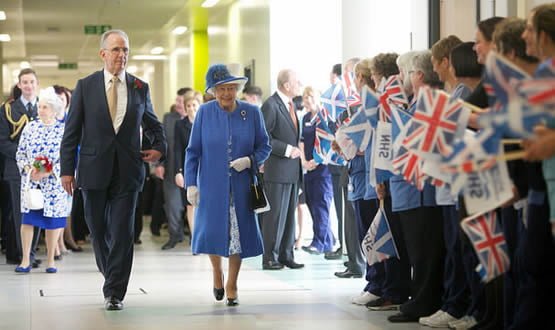IT belongs to Glasgow
- 27 August 2015

When NHS Greater Glasgow and Clyde decided to close down several of the city’s ageing hospitals to create a new ‘super hospital’ on the old site of the Southern General, it wanted to create a modern facility that was truly fit for the 21st century.
Step through the door of the newly-named Queen Elizabeth University Hospital, which opened in May this year, and it certainly seems like they have done the job.
The sun streams into the huge glass-ceilinged atrium that contains numerous open span waiting areas, a host of shops and a giant wall out of which protrude several rectangular pods, each a different bright pink, orange or purple. It all feels a bit more like a tourist resort rather than the place to go to see a doctor or nurse.
The use of technology is apparent, too. There are computer screens with bus times by the entrance, numerous self check-in kiosks dotted around the waiting areas, and a ‘Find Your Way’ screen, which patients and visitors can use to direct them around the 14-floor building, which contains 1,109 beds, each in its own room.
It’s a similar experience at the neighbouring 256-bed Royal Hospital for Children, where the waiting area contains numerous fun tools and toys – including a giant, wall-mounted touch screen sketch pad – all designed in partnership with interactive visitor attraction the Glasgow Science Centre.
Robots in the basement
It makes for a good first impression, but Pat McGorry, health information and technology service delivery manager at NHS Greater Glasgow and Clyde, is keen to explain that the innovations run deep.
Fittingly, our tour starts in the basement, which is home to one of the site’s most exciting innovations – the automated guided vehicles that act as robot porters to carry medical supplies, linen, food and waste around the site.
Once programmed by a member of the transport team, the robots, designed by Switzerland-based Swisslog, carry their loads around the miles of corridors beneath the two hospitals, using their own smart lifts to get to the necessary floor.
According to McGorry, around 99% of all loading of that type is now carried out by the AGVs, freeing up porters’ time to carry out other tasks, such as moving patients.
The AGVs have sensors that stop them bumping into walls, objects, people, or each other, while there is a left-lane system in place in the corridors.
In the event that one does stop working, staff can tap into their inner geek and use a remote control, which is very similar in design to a control pad for a games console, to manoeuvre them back into place.
Easier and simpler
The creation of a new hospital has allowed NHS Greater Glasgow and Clyde to look at other ways to improve its general functionality.
Every room has a unique code that staff can use to call for any necessary repairs or cleaning jobs, with these requests logged into the central system.
McGorry says this has “cut down on the frustration” of ward staff who, in the past, could end up on the phone numerous times throughout the day checking up on whether a request they had made was being carried out.
The way food orders are taken has been modernised, too, with support from tech company Synbiotix and its caterIT tool. Nurses can use a tablet to take orders and send these to a central system back in the catering department.
Another big advantage for patients is the entertainment system, including a free-to-view TV, and free wi-fi access that just requires users to tick a box and not to go through a complex sign-in process.
Getting clinical
These sorts of innovations have certainly added to the general functionality of the hospital, but a hospital wouldn’t be a 21st century hospital without the necessary clinical systems to support good care.
According to Neil Warbrick, HI&T acute account manager, there are around 400 applications at the site, with around 100 in the serious category. These range from specialist systems in paediatric intensive care with around 10 users to the health board’s patient administration system – InterSystems’ TrakCare, which has 19,000 users.
These systems had to be consolidated from each of the previous hospitals, says Warbrick. He gives as an example the adult intensive care system, Philips’ CareVue, which was in place in the ICU at one hospital, about to be implemented at another, but not in use at two.
“Before we got anywhere near the building our focus was to get the systems consolidated and get all intensive cares on the same system,” Warbrick says. “Then, when we moved in, we had a seamless way of working together, rather than having four beds working one way and four beds a different way.”
The same was true of TrakCare, which has replaced 20 separate legacy systems at different sites across Glasgow, each at a different level of maturity.
This work was carried out from September 2011 to May 2013, giving staff at each of the merging hospitals time to get used to the system before they moved onto the new site.
The system is now the basic clinical record and the main tool for a range of essential tasks, such as registering patients, nursing triage, discharging patients, producing discharge letters and order communications.
A ‘cornerstone’ solution
TrakCare is not the complete solution at NHS Greater Glasgow and Clyde, though, and the board has implemented a variety of ‘cornerstone’ products to create a fuller electronic patient record.
“There were a lot of things that I think it was assumed would be delivered through TrakCare that had to be reassessed in the light of experience,” says Robin Wright, director of HI&T. “That’s not to criticise. It’s just that we’ve learned what it’s good at and we’ve learned what it’s less good at.”
For those things TrakCare is good at, it is well-used. On an average week, 47,000 clinical letters are created, of which 37,000 are electronically delivered to GPs; 547,000 documents are rendered, and 195,000 lab requests are made using the order comms functionality.
However, for those things that it is “less good at”, NHS Greater Glasgow and Clyde has turned to other solutions. This includes the Orion Heath portal, which is the main way for staff to view a patient’s record and for medicines reconciliation.
The portal is not a new addition, with development starting in the area around ten years ago. Its use has meant that the health board has been able to phase out case notes at the majority of outpatient clinics and many inpatient areas.
“We have done, I think, what we ought to do with TrakCare,” says Wright. “It will be a steady, stable, trustworthy transactional environment. But we will rely on far more intuitive and clinician friendly tools for our EPR delivery environment; which will be a blend of other things but, predominately, the Orion portal.”
He acknowledges that this has made for some difficult conversations with InterSystems. “They want to be our world. But we have to say: ‘You are not our ecosystem, you are part of an ecosystem.’”
As an example, he says that the company “couldn’t understand” why the health board picked Nugensis’ WardView digital white board touchscreens.
It could have gone with an InterSystems solution to provide an immediate overview of all patients in a certain ward; but it felt the newcomer was more responsive and had a better fit with its needs.
Waiting for the right solution
There are certain areas where Wright is happy to wait to implement any solution, though, and that includes e-prescribing.
While many trusts in England are well on to way to implementing electronic prescribing and medicines management, spurred on by tech fund money, Wright says he doesn’t think the market is “quite there yet for us.”
“I think we are over focusing at the moment on pharmacy suppliers who have developed EPMA functionality on a modular basis. So I’m putting Glasgow and Clyde towards back of queue on that stuff.”
The same is true of electronic observations for nurses. Wright acknowledges the potential impact on patient safety, but isn’t sure if “the market has got very much to offer us” at the moment.
Fitting in on a national level
It’s an approach that fits with the Scotland’s national e-health strategy, which sets out seven general outcomes for the nation’s health boards, but is not prescriptive and does not lay out rigid deadlines.
“They are sensibly written, set outcomes against which local circumstances will dictate the pace,” Wright says. “They will build things up a bit at a time.”
So, NHS Greater Glasgow and Clyde can enjoy the success of its major move to a new site. But it is aware that this is not the end of the story, and there are steps still to be taken to improve the way it uses technology.
“For us it is clear to see where the drivers have been,” says Wright. “They’ve been in a rationalised acute services environment, focusing on this building. It’s about making this place another acute, rationalised estate that has a more efficient relationship with the general practice service.”




